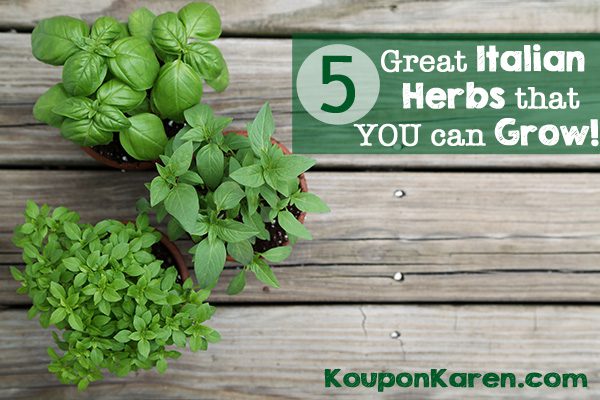Italian seasoning is one of the most commonly used seasonings, created from a combination of very well-paired and flavorful Italian herbs. The herbs that are needed to make your very own Italian seasoning are easy to grow in your own small herb garden outdoors in a bed, in containers or even indoors near a sunny window. Once your garden is growing you can start collecting and drying the herbs needed to put together a homemade recipe that will taste better than anything store bought.
There are five basic Italian herbs that are used to create Italian Seasoning. Use these tips to help you grow and gather what you need to make enough for all your cooking needs.
Five GREAT Italian Herbs That You Can Grow
Basil
Basil is used very liberally in a lot of Italian cooking, and it is one of the main ingredients, added in equal portion, or slightly more than the remaining herbs if you prefer its flavor to the others. This plant prefers moist soil, full sun and good soil, though not as nutrient rich as your vegetable garden soil. Basil is easy to grow from seed and can be successfully transplanted into a garden that drains well. Collect the leaves from the top down as they reach full size and place in a dry, dark location of the kitchen to dry out. Dried leaves can be crushed into smaller pieces.
Oregano
Oregano is a very strong flavored herb that is easy to dry out in order be added to seasoning mix. While it is very popular it Latin American dishes, it is actually native to the Mediterranean and used in a lot of Italian cooking. Depending on the variety you choose you will need to plant in a full sun to partial shade location. Start plants from seed, very well drained poor soil which will ensure that there is more flavor in the leaves. As oregano grows, pinch back the tops so that more leaves are produced. Harvest the mature stems with leaves as you go, drying them to add to your mix.
Rosemary
Rosemary is a very fragrant herb, that is also packed with a lot of flavor. The individual, pine needle like leaves are what you are going to collect and add to the mix. Add a rosemary transplant to the garden in rich to poor soil, with full sun available to it for at least eight hours every day. Make sure that the soil is well drained and that you fertilize at least once. Snip the entire stem, drying leaves on the stem and then removing when it has completely dried.
Thyme
Thyme is a huge flavor addition to Italian Seasoning, and very easily gathered and minced to be added to your homemade recipe. Thyme plants should be transplanted into your herb garden, in an easy to reach place because they are ground growers. Add them to well drained borders in partial to full sun with organic fertilizer added before planting. Thyme is a perennial, so it will grow back each year with the newest growth being harvested and dried.
Marjoram
This sweet tasting herb is a great container plant that grows well in cool weather, so add it to the garden in the beginning of spring. It does need some fertilizer, but not a lot all at once, so use a slow release product, or organic mulch that has been well mixed into the soil. A transplant is your best option if you want to be able to use the herb in the first season.






With all of your great reviews on growing herbs, you’ve talked me into trying it. These five that you have talked about are the herbs I use the most, so think I will pick a couple and give it a whirl. Thanks Karen! Wish me luck! 🙂
Good luck! Let me know how you do.
I love all of these herbs so I would definitely like to try to grow them! Thank you for the sun,soil,container and harvesting info! You were very thorough and that’s what I needed to start, lots of details!
(Five GREAT Italian Herbs That You Can Grow) I have some Basil that a friend gave me about a week ago to plant in my garden here at home. Now I just have to get a few other ones as well.
I’ve been wanting to start growing herbs.
They add so much to recipes.
thanks for the post
I have always wanted to try growing my own herbs but have never tried doing it yet.
Great idea and tips, I’ve been thinking of growing an herb garden, its one of my to do projects.
I grow basil and I love it. It’s turned out better than I hoped and I actually like it better than store bought basil when I use it in recipes.
I love my herb garden.Basil doesn ot do well for me.
Would have to say that this is great for cooking.
Love to grow these because nothing beats cooking with fresh herbs. My kids love planting plants so will have to grow these for our garden.
I would love to grow these but sadly I kill everything!
Growing season is over here in Maine, but I’m going to bring in my potted rosemary and oregano to overwinter. They don’t do great indoors, but they survive well enough that I can use them from time to time and then put them outside again in the spring. I have some thyme that I planted indoors and never put out, and now you’ve got me wondering if I could grow basil inside, too. There is nothing like fresh basil!
I love fresh basil so much!!!
we live in townhouse,where we have small place for plants to grow,maybe i should try plant few herbs,i love fresh ones.
Now that I am trying to cook more for my kids, I should try something like this and let them all help me out with it so it would be fun too